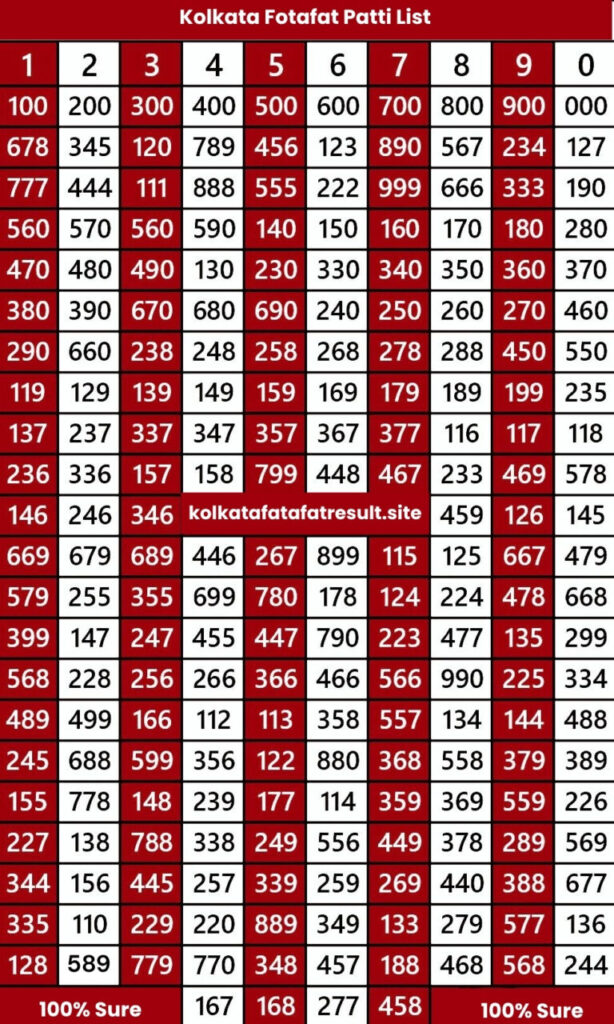
Table of Contents
Kolkata Fatafat Patti Chart Results – Complete Reference
Welcome to the Kolkata Fatafat Patti Chart Result Page at KolkataFatafatResult.site – your reliable hub for all Patti chart results.
Here, you can explore daily Patti charts, observe number patterns, and gain educational insights about the game. This page is designed for informational purposes only. We do not provide fixed results, VIP predictions, or guaranteed numbers.
Disclaimer: The Patti chart results are for educational and historical reference. No chart guarantees future outcomes.
What is a Patti chart?
The Patti Chart is an organised representation of Kolkata Fatafat (FF) results based on 3-digit combinations. Each Patti represents a set of numbers drawn in daily results.
Key points:
- Educational Tool: Helps players study trends and understand historical patterns.
- Not for Prediction: The chart is purely informational.
- Historical Reference: Shows the 3-digit combinations from past results.
Note: Relying on the Patti Chart for guaranteed outcomes is unsafe and discouraged.
Why Use the Patti Chart?
- Trend Analysis: Observe which 3-digit combinations appear more often.
- Pattern Awareness: Track recurring Patti sets in historical data.
- Educational Learning: Understand the frequency and spread of results.
- Safe Observation: Avoid impulsive gambling decisions by studying historical charts.
The Patti Chart is part of Kolkata Fatafat Tips Today Awareness, Kolkata FF Tips SM, and Fatafat Tips Educational Practice.
Understanding the Patti Chart
- 3-Digit Groupings: Each Patti contains a set of 3 numbers.
- Bazi-wise Segmentation: Results are recorded for all 8 bazi of the day:
| Bazi | Time |
| 1st Bazi | 10:20 AM |
| 2nd Bazi | 11:50 AM |
| 3rd Bazi | 01:20 PM |
| 4th Bazi | 02:50 PM |
| 5th Bazi | 04:20 PM |
| 6th Bazi | 05:50 PM |
| 7th Bazi | 07:20 PM |
| 8th Bazi | 08:50 PM |
- Pattern Study: Users can observe which Patti numbers are frequent across multiple bazi.
- Educational Awareness: Helps understand historical frequency without expecting predictions.
Benefits of Studying Patti Charts
- ✅ Observe Repeated Numbers: Track recurring 3-digit sets.
- ✅ Educational Learning: Study historical results safely.
- ✅ Pattern Awareness: Understand odd/even tendencies and high/low number distributions.
- ✅ Responsible Observation: Helps reduce impulsive gambling.
- ✅ Safe and Legal: Patti charts are for informational purposes only.
⚠️ Avoid relying on any chart for guaranteed outcomes.
Example Patti Chart (Informational)
| Date | 1st Bazi Patti | 2nd Bazi Patti | 3rd Bazi Patti | 4th Bazi Patti | 5th Bazi Patti | 6th Bazi Patti | 7th Bazi Patti | 8th Bazi Patti |
| 25 Nov 2025 | 123 | 456 | 789 | 234 | 567 | 891 | 345 | 678 |
| 24 Nov 2025 | 321 | 654 | 987 | 432 | 765 | 198 | 543 | 876 |
| 23 Nov 2025 | 132 | 465 | 798 | 243 | 576 | 819 | 354 | 687 |
Note: These charts are archival results only and cannot predict future outcomes.
How to Use the Patti Chart Safely
- Observe Trends Across Days: Study 3–5 consecutive days to understand recurring patterns.
- Analyse Odd/Even and High/Low Combinations: Notice tendencies without assuming repetition.
- Educational Tracking: Maintain a personal record for learning and observation.
- Avoid Prediction Dependence: Patti charts are for historical reference, not predictions.
Using Patti Charts responsibly helps you study results, learn trends, and stay aware.
Tips for Educational Use
- Check all 8 Bazi Patti numbers daily.
- Track which 3-digit sets appear more often in the last 30 days.
- Compare morning vs evening patterns.
- Focus on safe observation, not gambling or fixed outcomes.
- Understand how trends fluctuate naturally over days.
These are part of Kolkata Fatafat Live Tips Fatafat Awareness and Fatafat Tips Ghosh Babu Educational Practice.
FAQs on Patti Chart Results
What is a Patti Chart in Kolkata Fatafat?
It’s a historical record of 3-digit combinations from daily results, for informational purposes only.
Can Patti Charts guarantee winning numbers?
No. Patti charts are purely educational and do not ensure outcomes.
How often is the chart updated?
Daily, after all 8 bazi results are officially announced.
Are these charts legal?
Yes, they are legal because they provide historical reference only.
Can I use the chart for trends?
Yes, for educational pattern observation only.
Do I need to pay to access Patti Charts?
No, it is completely free on our website.
How many bazi are there in a day?
There are 8 bazi daily, from 10:20 AM to 8:50 PM.
Can I compare Patti charts across months?
Yes, it’s useful for learning trends and patterns over time.
Are charts verified?
Yes, we provide historical data collected from trusted sources.
Can I rely on the chart for VIP predictions?
No. The chart is educational, not predictive.
Responsible Observation Guidelines
- Only use the Patti chart to study historical results.
- Avoid assumptions that past patterns will repeat.
- Do not chase “sure-shot” or VIP predictions.
- Combine chart study with safe, responsible awareness.
- Maintain personal records for educational purposes, not gambling.
Final Words
The Kolkata Fatafat Patti Chart page is a safe, trustworthy educational tool for learning historical patterns and trends.
Key Takeaways:
✔ Charts are informational only.
✔ No predictions, VIP numbers, or guaranteed outcomes.
✔ Focus on safe observation and pattern learning.
✔ Stay updated with official daily results for accuracy.
Studying Patti charts can be fun, informative, and educational if used responsibly.
Always remember: Past results are for learning, not prediction.